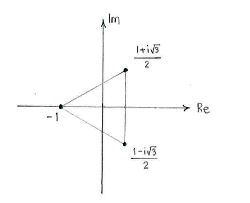Lösung 3.3:2b
Aus Online Mathematik Brückenkurs 2
K (Lösning 3.3:2b moved to Solution 3.3:2b: Robot: moved page) |
|||
| Zeile 1: | Zeile 1: | ||
| - | {{ | + | The The equation |
| - | < | + | <math>z^{3}=-\text{1 }</math> |
| - | {{ | + | is a so-called binomial equation, which we solve by writing both sides in polar form. We have |
| - | {{ | + | |
| - | < | + | |
| - | {{ | + | <math>\begin{align} |
| + | & z=r\left( \cos \alpha +i\sin \alpha \right) \\ | ||
| + | & -1=1\left( \cos \pi +i\sin \pi \right) \\ | ||
| + | \end{align}</math> | ||
| + | |||
| + | |||
| + | and, with the help of de Moivre's formula, the equation becomes | ||
| + | |||
| + | |||
| + | <math>r^{3}\left( \cos 3\alpha +i\sin 3\alpha \right)=1\left( \cos \pi +i\sin \pi \right)</math> | ||
| + | |||
| + | |||
| + | Both sides are equal when their magnitudes are equal and the arguments differ by a multiple of | ||
| + | <math>2\pi </math>, | ||
| + | |||
| + | |||
| + | <math>\left\{ \begin{array}{*{35}l} | ||
| + | r^{3}=1 \\ | ||
| + | 3\alpha =\pi +2n\pi \quad \left( n\text{ an arbitrary integer} \right)\text{ } \\ | ||
| + | \end{array} \right.</math> | ||
| + | |||
| + | which gives that | ||
| + | |||
| + | |||
| + | <math>\left\{ \begin{array}{*{35}l} | ||
| + | r=1 \\ | ||
| + | \alpha =\frac{\pi }{3}+\frac{2n\pi }{3}\quad \left( n\text{ an arbitrary integer} \right)\text{ } \\ | ||
| + | \end{array} \right.</math> | ||
| + | |||
| + | |||
| + | |||
| + | For every third integer | ||
| + | <math>n</math>, the solution formula gives in principal the same value for the argument (the difference is a multiple of | ||
| + | <math>2\pi </math>), so the equation has in reality three solutions (for | ||
| + | <math>n=0,\ 1</math> | ||
| + | and | ||
| + | <math>\text{2}</math>): | ||
| + | |||
| + | |||
| + | <math>z=\left\{ \begin{array}{*{35}l} | ||
| + | 1\centerdot \left( \cos \frac{\pi }{3}+i\sin \frac{\pi }{3} \right) \\ | ||
| + | 1\centerdot \left( \cos \pi +i\sin \pi \right) \\ | ||
| + | 1\centerdot \left( \cos \frac{5\pi }{3}+i\sin \frac{5\pi }{3} \right) \\ | ||
| + | \end{array} \right.=\left\{ \begin{array}{*{35}l} | ||
| + | \frac{1+i\sqrt{3}}{2} \\ | ||
| + | -1 \\ | ||
| + | \frac{1-i\sqrt{3}}{2} \\ | ||
| + | \end{array} \right.</math> | ||
| + | |||
| + | We obtain the typical behaviour that the solutions are corner points in a regular polygon (a triangle in this case because the degree of the equation is | ||
| + | <math>\text{3}</math>). | ||
| + | |||
| + | |||
[[Image:3_3_2_b.gif|center]] | [[Image:3_3_2_b.gif|center]] | ||
Version vom 10:01, 24. Okt. 2008
The The equation \displaystyle z^{3}=-\text{1 } is a so-called binomial equation, which we solve by writing both sides in polar form. We have
\displaystyle \begin{align}
& z=r\left( \cos \alpha +i\sin \alpha \right) \\
& -1=1\left( \cos \pi +i\sin \pi \right) \\
\end{align}
and, with the help of de Moivre's formula, the equation becomes
\displaystyle r^{3}\left( \cos 3\alpha +i\sin 3\alpha \right)=1\left( \cos \pi +i\sin \pi \right)
Both sides are equal when their magnitudes are equal and the arguments differ by a multiple of
\displaystyle 2\pi ,
\displaystyle \left\{ \begin{array}{*{35}l}
r^{3}=1 \\
3\alpha =\pi +2n\pi \quad \left( n\text{ an arbitrary integer} \right)\text{ } \\
\end{array} \right.
which gives that
\displaystyle \left\{ \begin{array}{*{35}l}
r=1 \\
\alpha =\frac{\pi }{3}+\frac{2n\pi }{3}\quad \left( n\text{ an arbitrary integer} \right)\text{ } \\
\end{array} \right.
For every third integer \displaystyle n, the solution formula gives in principal the same value for the argument (the difference is a multiple of \displaystyle 2\pi ), so the equation has in reality three solutions (for \displaystyle n=0,\ 1 and \displaystyle \text{2}):
\displaystyle z=\left\{ \begin{array}{*{35}l}
1\centerdot \left( \cos \frac{\pi }{3}+i\sin \frac{\pi }{3} \right) \\
1\centerdot \left( \cos \pi +i\sin \pi \right) \\
1\centerdot \left( \cos \frac{5\pi }{3}+i\sin \frac{5\pi }{3} \right) \\
\end{array} \right.=\left\{ \begin{array}{*{35}l}
\frac{1+i\sqrt{3}}{2} \\
-1 \\
\frac{1-i\sqrt{3}}{2} \\
\end{array} \right.
We obtain the typical behaviour that the solutions are corner points in a regular polygon (a triangle in this case because the degree of the equation is \displaystyle \text{3}).

